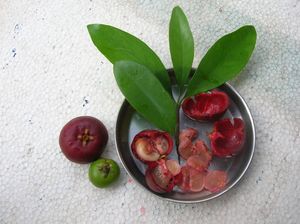Note: This is a project under development. The articles on this wiki are just being initiated and broadly incomplete. You can Help creating new pages.
Difference between revisions of "Garcinia indica - Vrikshamia"
| Line 2: | Line 2: | ||
'''Garcinia indica''' a plant in the mangosteen family. It is native to Asia and Africa. Garcinia indica is indigenous to the Western Ghats region of India located along the western coast of the country. | '''Garcinia indica''' a plant in the mangosteen family. It is native to Asia and Africa. Garcinia indica is indigenous to the Western Ghats region of India located along the western coast of the country. | ||
==Uses== | ==Uses== | ||
| − | {{Uses|Indigestion}}, {{Uses|Cuts}}, {{Uses|Snakebites}}, {{Uses|Diabetes}}, {{Uses|Cancers}}, {{Uses|Skin problems}}, {{Uses|Pimples}}, {{Uses|Diarrhea}}, {{Uses|Sore throats}} | + | {{Uses|Indigestion}}, {{Uses|Cuts}}, {{Uses|Snakebites}}, {{Uses|Diabetes}}, {{Uses|Cancers}}, {{Uses|Skin problems}}, {{Uses|Pimples}}, {{Uses|Diarrhea}}, {{Uses|Sore throats}}. |
==Parts Used== | ==Parts Used== | ||
| Line 8: | Line 8: | ||
==Chemical Composition== | ==Chemical Composition== | ||
| − | Cyanidin-3-glucoside and cyanidin-3-sambubioside<ref name="chemical composition"/> | + | Cyanidin-3-glucoside and cyanidin-3-sambubioside.<ref name="chemical composition"/> |
==Common names== | ==Common names== | ||
| Line 40: | Line 40: | ||
===Fruit=== | ===Fruit=== | ||
| − | {{Fruit|Berry|2.5-4 cm across||4-8 loculed, purple or wine brown, surrounded by persistent calyx; pulp red| | + | {{Fruit|Berry|2.5-4 cm across||4-8 loculed, purple or wine brown, surrounded by persistent calyx; pulp red|Seeds 5-8, compressed in acidic pulp}} |
===Other features=== | ===Other features=== | ||
| Line 67: | Line 67: | ||
==References== | ==References== | ||
| − | |||
<references> | <references> | ||
| − | <ref name="chemical composition">[https://www.tandfonline.com/doi/full/10.1080/10942910802626754?src=recsys | + | <ref name="chemical composition">[https://www.tandfonline.com/doi/full/10.1080/10942910802626754?src=recsys Main constituents]</ref> |
| − | <ref name="Leaf">FLOWERING PLANTS OF KERALA VER.2, N. Sasidharan | + | <ref name="Leaf">FLOWERING PLANTS OF KERALA VER.2, N. Sasidharan-Botanical description</ref> |
<ref name="Ayurvedic preparations">[https://easyayurveda.com/2015/05/18/kokum-garcinia-indica-uses-dose-research-side-effects/ Ayurvedic preparations]</ref> | <ref name="Ayurvedic preparations">[https://easyayurveda.com/2015/05/18/kokum-garcinia-indica-uses-dose-research-side-effects/ Ayurvedic preparations]</ref> | ||
Revision as of 16:25, 22 May 2020
Garcinia indica a plant in the mangosteen family. It is native to Asia and Africa. Garcinia indica is indigenous to the Western Ghats region of India located along the western coast of the country.
Contents
- 1 Uses
- 2 Parts Used
- 3 Chemical Composition
- 4 Common names
- 5 Properties
- 6 Habit
- 7 Identification
- 8 List of Ayurvedic medicine in which the herb is used
- 9 Where to get the saplings
- 10 Mode of Propagation
- 11 How to plant/cultivate
- 12 Commonly seen growing in areas
- 13 Photo Gallery
- 14 References
- 15 External Links
Uses
Indigestion, Cuts, Snakebites, Diabetes, Cancers, Skin problems, Pimples, Diarrhea, Sore throats.
Parts Used
Chemical Composition
Cyanidin-3-glucoside and cyanidin-3-sambubioside.[1]
Common names
| Language | Common name |
|---|---|
| Kannada | Murgina, Punarpuli |
| Hindi | Kokum |
| Malayalam | Kaattampi |
| Tamil | Murgal, Murgal-mara |
| Telugu | |
| Marathi | NA |
| Gujarathi | NA |
| Punjabi | NA |
| Kashmiri | NA |
| Sanskrit | Vrikshamia, Amlabija |
| English | Kokam, Goa butter tree |
Properties
Reference: Dravya - Substance, Rasa - Taste, Guna - Qualities, Veerya - Potency, Vipaka - Post-digesion effect, Karma - Pharmacological activity, Prabhava - Therepeutics.
Dravya
Rasa
Amla (sour), Madhura (sweet)
Guna
Ruksha (Dry), Guru (heavy)
Veerya
Ushna (Hot)
Vipaka
Madhura (sweet)
Karma
Kapha, Vata
Prabhava
Habit
Identification
Leaf
| Kind | Shape | Feature |
|---|---|---|
| Simple | Opposite | Estipulate; petiole 5-12 mm long, slender, glabrous; lamina 6.5-11 x 1.5-4 cm, lanceolate or obovate-oblong, base attenuate. |
Flower
| Type | Size | Color and composition | Stamen | More information |
|---|---|---|---|---|
| Polygamodieocious | Axillary and terminal fascicles | Many | Pedicels 6 mm long; sepals 4, yellowish-orange to pinkish-orange, coriaceous, ovate-rotundate, outer ones 3-4.5 mm long, inner ones 4.5-5 mm long. |
Fruit
| Type | Size | Mass | Appearance | Seeds | More information |
|---|---|---|---|---|---|
| Berry | 2.5-4 cm across | 4-8 loculed, purple or wine brown, surrounded by persistent calyx; pulp red | Seeds 5-8, compressed in acidic pulp | {{{6}}} |
Other features
List of Ayurvedic medicine in which the herb is used
Where to get the saplings
Mode of Propagation
How to plant/cultivate
It can be propagated through soft wood grafts. Garcinia indica requires a warm and humid tropical climate.[4]
Commonly seen growing in areas
Forest lands, Riversides, Wastelands.
Photo Gallery
References
- ↑ Main constituents
- ↑ FLOWERING PLANTS OF KERALA VER.2, N. Sasidharan-Botanical description
- ↑ Ayurvedic preparations
- ↑ "Cultivation Details"
External Links
- Ayurvedic Herbs known to be helpful to treat Indigestion
- Ayurvedic Herbs known to be helpful to treat Cuts
- Ayurvedic Herbs known to be helpful to treat Snakebites
- Ayurvedic Herbs known to be helpful to treat Diabetes
- Ayurvedic Herbs known to be helpful to treat Cancers
- Ayurvedic Herbs known to be helpful to treat Skin problems
- Ayurvedic Herbs known to be helpful to treat Pimples
- Ayurvedic Herbs known to be helpful to treat Diarrhea
- Ayurvedic Herbs known to be helpful to treat Sore throats
- Herbs with Leaves used in medicine
- Herbs with common name in Kannada
- Herbs with common name in Hindi
- Herbs with common name in Malayalam
- Herbs with common name in Tamil
- Herbs with common name in Sanskrit
- Herbs with common name in English
- Habit - Tree
- Index of Plants which can be propagated by Seeds
- Index of Plants which can be propagated by Grafting
- Herbs that are commonly seen in the region of Forest lands
- Herbs that are commonly seen in the region of Riversides
- Herbs that are commonly seen in the region of Wastelands
- Herbs
- Ayurvedic herbs that don't have seed photos
- Clusiaceae



